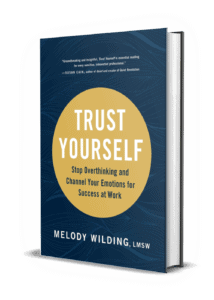Joel opened his calendar app for the fifth time in an hour. Then he nervously tapped his pen on his desk. Work-from-home paranoia had a tight grip on his thoughts. No one from upper management has even acknowledged my email from this morning. I guess everyone hated my proposal. What if they’re getting ready to fire me?
Pre-pandemic studies showed that remote employees have always been more likely to feel unsupported and left out. However, paranoia has significantly increased since the pandemic started due to isolation, increased stress, and heavier workloads. These struggles have been particularly difficult for sensitive strivers – high-achieving individuals who process the world more deeply. Due to sensitive strivers’ perceptiveness, rising stress levels lead them to doubt themselves and overthink.
Facial expressions, body language, and subtleties are all much harder to understand from a distance. And when you work from home every day, you may find yourself overthinking and replaying the same events over and over. The natural camaraderie of a non-remote work environment evaporates when you and all your colleagues are confined at home. In the absence of social reassurance and casual nods of approval, which are common in healthy office environments, it’s all too easy for negativity to thrive.
Working from home does offer challenges, but the paranoia it may trigger can be overcome. The following tactics can ward off baseless suspicions and restore your focus on what’s really important.
4 Tactics to Combat Work-From-Home Paranoia
Articulate your expectations.
You can prevent misunderstandings and faulty assumptions by being proactive and setting expectations in advance. That way, you’ll prepare colleagues, stakeholders, and management for the future in terms of decision-making, communication styles, and potentially difficult topics like differences of opinion and conflict resolution.
For instance, let’s say you make an agreement with someone on your team about deadlines and how to communicate about your project. Together, you decide that at the current stage of your work together, you need input on a granular level. You also learn that this colleague is detail-oriented and conscientious. Thanks to careful calibration of everyone’s expectations, you’re less likely to feel guilt or shame as if you’ve done something wrong, or to sink into paranoia if they have extensive feedback.
One approach to setting explicit expectations is to compile a list of official working agreements with best practices for positive collaboration. These strategies could include speaking only on behalf of yourself, maintaining an open mind towards everyone’s ideas, and responding to all messages within 24 hours. Another way to set guidelines for working together is by writing a “user manual” that details factors like your learning style, your work schedule, and your personal strengths and weaknesses.
Be cautious about scope creep.
When you’re prone to work-from-home paranoia, you may find yourself fighting the urge to overextend yourself, and struggling with people-pleasing impulses. Your insecurities may compel you to sit in on every meeting, regardless of whether your presence is required. Your desire for control – or an illusion of control – may pull you towards over-involvement. Your flawed logic may tell you that if you remain present at all times, no one can put anything past you. But if you fall prey to mental traps like these, you’ll find yourself in burnout.
This trend can be reversed in a few simple steps. Start by performing a schedule audit. Cancel or eliminate any unnecessary meetings. See if you can send a collaborator or direct report to attend, then report back to you with notes. You’ll feel uncomfortable when you cut the cord like this. That discomfort is a sign that you’re transforming your relationship with fear and growing your tolerance for ambiguity.
Don’t take things personally at work
If you are a sensitive striver, you probably have high empathy. It’s both a gift and a hardship to feel emotions so deeply. You are adept at sensing the needs of those around you, and most likely excel at perceiving morale. The shadow side of this gift may lead you to take the behavior of other people personally. For example, you might misinterpret an offhand remark as a slight.
When you catch yourself gazing into paranoia’s funhouse mirror, try putting your empathy to good use. Imagine the other person’s point of view and ask yourself why they might be having that particular response. Can you find a more generous way to interpret their behavior?
That’s what Joel did when his supervisor seemed unhappy about the pace of work on a project. Joel took a deep breath and used his empathy to see things from his supervisor’s perspective and to look for other factors he hadn’t considered yet. This helped him realize that his supervisor’s response had nothing to do with Joel’s performance or any mistakes he may have made. Instead, it was because the supervisor felt edgy and drained at the end of a long day in senior leadership meetings.
Practice compartmentalization with your anxieties.
Work-from-home paranoia can become a round-the-clock companion if you don’t maintain good boundaries. According to a recent study, 80% of workers have trouble “shutting off” in the time between the end of the workday and going to sleep. This statistic points to the need for mental detachment and disconnection from workplace worries in the evening.
My clients have gotten great results from a strategy I call “the backpack.” Imagine placing worrisome situations from your workday into a backpack that you set down in your home office and leave there overnight. Or, if you’d rather try a physical version of this exercise, sketch a rectangle on a piece of paper and jot down your problems. Then rip up the paper and toss it in the trash, to symbolically detach from the problems of your day.
It can be a competitive advantage to stay vigilant and attuned to everything that happens at work. If you take this too far, though, it results in paranoia and paralysis. With mindful management of your thoughts and emotions, you can triumph over the difficulties of remote work.
Want to Learn More? Check Out My LinkedIn Learning Course
This course summarizes tools and strategies I’ve used over the past ten years with coaching clients at companies like Google, Amazon, and more.
Let go of overthinking from Overcome Overthinking by Melody Wilding
This course will show you how to:
- Stop worrying about things you can’t control
- Make better, faster decisions with less stress
- Build your confidence instead of dwelling on your shortcomings
- Conquer fear and take braver action in your career
When you sign up now, you get access to the course plus additional worksheets, templates, and more.
Start the course now for free with LinkedIn Premium, or sign up for just $24.99.
Some links in this article are affiliate links. This means that I may receive a commission if you click on the link and make a purchase from the affiliate.









